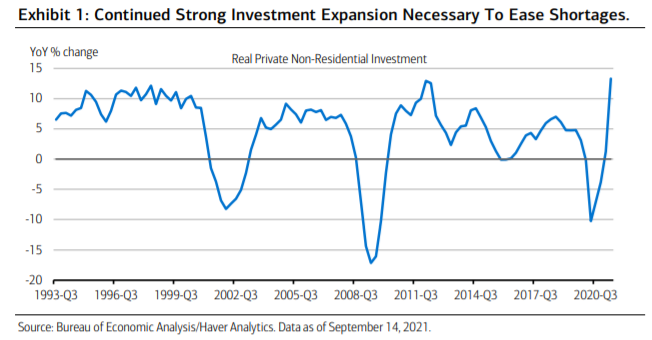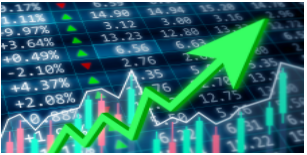Merrill hæfter sig ved, at økonomien har udviklet sig helt anderledes end ventet under pandemien – på alle områder – og at den teknologiske udvikling og klima-politikken også har haft en stor virkning. F.eks. er det den massive vækst i el-biler, der har ført til voldsomme forsyningsvanskeligheder omkring chips. Dette og det ekstremt høje forbrug har øget investeringerne massivt, ikke mindst fordi virksomhedernes indtjening har været særdeles høj. S&P 500-indtjeningen steg med 15 pct. i første halvår, og det førte til den største stigning i indtjeningsforventningerne, der er set i 45 år. Merrill forventer også en pæn stigning i investeringerne næste år, på 7 pct., og alt i alt indikerer det et stærkt aktiemarked.
Strong U.S. Capex Outlook
The economic recovery out of the pandemic shutdown was not expected to be V-shaped,
fiscal transfers were not expected to create labor shortages, and inflation was not
expected to be high and sustained.
Instead, U.S. real gross domestic product (GDP) got
back on its 1995-to-2019 trend by early 2021, businesses have never reported bigger
difficulty finding labor, and annualized consumer durable-goods inflation averaged 17%
between January and August, its highest reading since this Bureau of Labor Statistics
inflation series began in 1956.
This shouldn’t be surprising, since, as discussed in past reports, the nature of the shock
and unparalleled government response to the pandemic have boosted inflation-adjusted
demand for consumer durable goods this year 35% above its 1995-to-2019 trend,
according to data from the Bureau of Economic Analysis, much in excess of domestic
supply, even though manufacturing output also rebounded quickly.
Still, with domestic industrial equipment spending lagging since 2001, when China entered
the World Trade Organization (WTO), manufacturing output flatlining, and reliance on
imports increasing, it’s not surprising to see the past year’s surge in demand result in
major logistical bottlenecks and shortages.
What’s more, as ongoing semiconductor chip shortages caused by coronavirus-related
Asian production disruptions and the government-stimulus-fueled surge in demand for
consumer electronics and other “smart” goods starved carmakers of necessary
components, motor-vehicle inventories are expected to remain depressed relative to
demand.
The sudden global swing in favor of vastly boosting production of electric vehicles (EV),
which reportedly use 10 times more chips than current internal-combustion car models, is
likely exacerbating the shortage of chips.
Shortages, combined with very elevated excess personal savings and labor income growth
running at an almost 10% pace through August and likely to remain robust
because of exceptionally strong labor demand and accelerating wages, suggest that
consumer demand should remain elevated, keeping economic growth and inflation high by
the standards of the past two decades.
Leading indicators of
employment suggest hiring should increase at about a 3%-to-4% pace over the next year
(twice, or more, as fast as between 2013 and 2019), resulting in millions more paychecks
and a further decline in the unemployment rate to about 4% in 2022. With wages also
rising the most in two or three decades, this implies strong income gains and firm support
for economic activity.
Thus, in our view, there’s much fuel for consumer spending growth
ahead even absent enhanced unemployment benefits. This means corporate revenue
growth is likely to remain strong. Given our domestic income and spending outlook, as well
as improving pandemic-related conditions overseas and massive backlogs of unfilled
manufacturing orders, we expect corporate revenue growth of about 10% to 14% in 2021
and 2022. This would be at the top of the range that prevailed in the past 30 years, and
combined with low interest costs should help keep profit margins high, in our view, despite
rising input costs.

Q2 GDPbased data show pre-tax domestic profit margins expanding to a 7-year high. What’s more,
company earnings reports have generally indicated management confidence in the ability
to keep margins high, or rising, as a result of unprecedented pricing power. Supporting this
view, the Evercore ISI Research proprietary survey of company pricing power has increased
to a fresh record.
In light of S&P 500 revenue surging 15% in the first half and margins expanding, analysts
have revised their 2021 profits estimates by the most in 45 years (about 25% from their
January forecast), boosting equity prices and helping keep credit spreads much narrower
than expected.
We expect more upside for profits as well as real nonresidential CapEx, after its 13%
year-over-year (YoY) surge in Q2 to a new record (Exhibit 1). Unprecedented labor constraints
spurring automation and productivity enhancements alongside concerns about supply chain
resilience also suggest sustained robust domestic investment.
The rebound in capex has been led by real industrial equipment spending, which reached a
fresh record 7% above the pre-pandemic peak in Q2. All in all, we expect real
business investment to increase around 6% to 7% in 2021 and 2022, which would be on the
strong side by the standards of the past 20 years.




